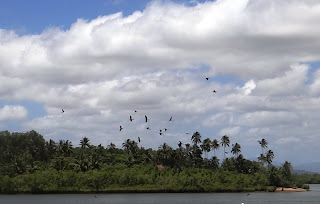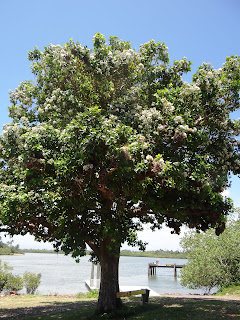During Ron's time as Deputy Chairman for the Douglas Shire he was the driving force to convert the 'Bloomfield Trail' to an all weather road. Later, Ron told me he came to think the road was a costly mistake.
To the very last weeks of his life Ron was a popular presence at community markets with his grafted eggplants, tomatoes and his wise advise to anyone who wanted help to grow food in the Wet Tropics.
Rhonda and family we share your sorrow and we honour Ron for his contribution to horticulture, echo tourism and the arts in Far North Queensland.
There is a link in the right hand tab to two articles I wrote about Ron in my 'Growing' blog. If you wish to read about Ron click on January 2011; 'Why they built a road through the Daintree rainforest' and in the same issue 'Ron Berry'.
An unusual weather pattern over the last few weeks has brought strong, cool winds to coastal Queensland. While October is normally quite hot, this year we are experiencing night time temperatures around 18degrees and daytime just under 30degrees. Combined with very low humidity we are enjoying the mildest of October weather.
The strong winds have kept the fishers in the river and all week fishing mates in small boats have been darting around the mangroves looking to catch a feed of fish.
In the rain forest the black bean, castanospermum australe, are in full bloom. The bright yellow flowers and orange bracts attract rainbow lorikeets, flying foxes, spangled drongos and other nectar eating birds. While drinking the nectar the birds and bats pollinate the flowers and within a few months the large seed pods develop.
On Thursday when the lorikeets finished feeding in the black bean tree they flew to a nearby candle nut, aleurites rockinghamensis, where a nutmeg pigeon was warming herself in the early morning sun. This is her preferred sunning spot and almost every morning I see her in this candle nut. Nutmeg sat fixed on her perch as the lorikeets harassed and screeched loudly at her. Eventually, tied of the game they flew off.
Contrasting against the deep green of the rain forest's canopy, and also flowering this week, is the white-apple tree, syzygium forte. Large clusters of white-apple flowers attract moths and butterflies to feast on their nectar. Soon clusters of white fruits will develop, a favourite food of nutmeg pigeons, cassowaries, flying foxes and the pig-nosed turtle.
The canopy of the wet tropics rain forest is an ever changing mosaic of coloured leaves,flowers and fruits.
On the northern side of the Johnstone River, in the area called The Coconuts, several white-apple trees have been planted in a small park. In one of these trees near the boat-ramp metallic starlings have built their nests.
 Flocks of metallic starlings cross the Johnstone River, from their tree at The Coconuts, to feed in the rain forest and collect nest building material from Coquette Point.
Flocks of metallic starlings cross the Johnstone River, from their tree at The Coconuts, to feed in the rain forest and collect nest building material from Coquette Point.
the rays of the setting sun create a rainbow on its shiny breast feathers.
 In the warm spring sunshine butterflies are busy laying eggs for the next generation. Above a female Cairns Bird-wing rest from the wind.
In the warm spring sunshine butterflies are busy laying eggs for the next generation. Above a female Cairns Bird-wing rest from the wind.
her wings in the early morning sunshine.
 Fluttering hither and thither across the canopy of the rain forest and only occasionally stopping for a rest the tailed-green-banded-blue butterfly lays her eggs on the match-box bean vine. The distinctive caterpillars are bright green with a pale brown head.
Fluttering hither and thither across the canopy of the rain forest and only occasionally stopping for a rest the tailed-green-banded-blue butterfly lays her eggs on the match-box bean vine. The distinctive caterpillars are bright green with a pale brown head.
Spring of course is the month when moths especially are active laying their eggs, much to every gardeners distress, often on cabbages and tomato plants.
A spray containing 5mls of eucalyptus oil and 5 mls of detergent in one litre of water and sprayed on vegetables and fruit once a week will deter the mother moth from laying her eggs on plants and fruits.
The scaly patterns of moths is every bit as remarkable as those of butterflies and many day flying species of moths can be observed around the rain forest canopy and in the protected understory. However, to appreciate their diversity you need to observe the huge variety of nocturnal moths active in the night time. Below are a few moths I have seen, active during the day, this week.
weird and diverse and none more so than the spiny leaf insect. What does a bitten leaf matter when you have a spectacular creature like this in your garden?
all week with the male and female (above) calling excitedly from their roosting trees. The metallic starlings and the pheasant coucals should watch out as Mrs Indian koel is looking for a surrogate parent for her eggs.
looking for water and Dot is again coming into the nursery regularly for a drink.
I was busy weeding when Dot came up behind me and looked right in my weed bucket, it gave me quite a start.
 I found Dad 1's second chick, unnamed, sleeping under a tree at the top of the Moresby Range. Any suggestions for his name?
I found Dad 1's second chick, unnamed, sleeping under a tree at the top of the Moresby Range. Any suggestions for his name?
The sub adult of unknown parents also turned up again this week. He was skittish and soon ran off.
Diana O'Brian sent me some photos of 'Little Dad' with only one chick now surviving.
We had all hoped that this was another new cassowary with just one chick but a careful comparisions of the two photos showing watles and casque appear to show it is 'Little Dad' with 'Cheeky'.
Diana O reported that on Wednesday afternoon she saw a large male cassowary with two very small chicks crossing the Coquette Point road near the old foresty track. It could be 'Brown Cone' or 'Dad 1' with the chicks, no doubt I will see them soon and be able to confirm the Dad; its wonderful news.
Coquette Point was well represented at a function in the Shire Hall to support the National Disability Insurance Scheme. Clive Strickland was Master of Ceremonies, John O'Brien entertained us.
In the photo below John is in the 'zone' for a his wonderful rendition of' 'Mak the Knife'. Very well done John.
Bill Farmsworth did all the heavy lifting to take plants in to decorate the hall and the Nursery was happy to be a sponser and support the event; my Irish eyes are still smiling.
Cheers for now,
Yvonne C.














.JPG)











I came across your blog looking for the name of particular moth that you have a photo of.
ReplyDeleteI have enjoyed your corner of FNQ and the wildlife you have there!
AdrienneW